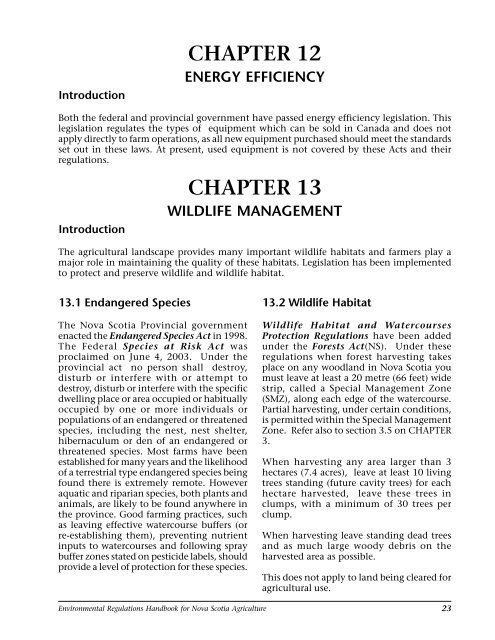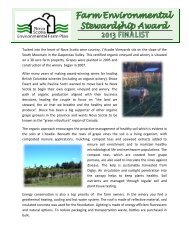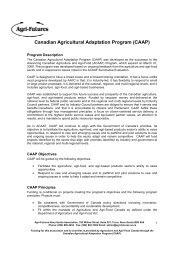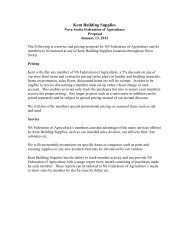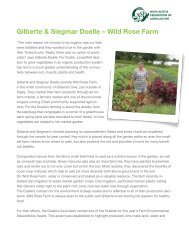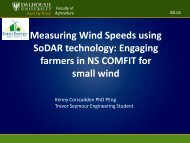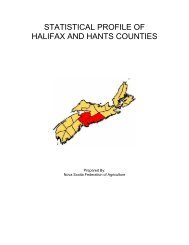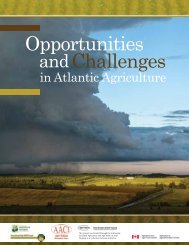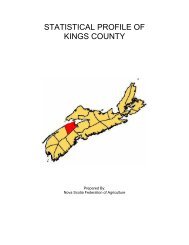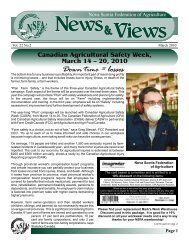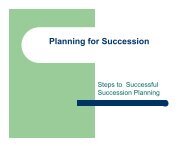Environmental Regulations Handbook for Nova Scotia Agriculture
Environmental Regulations Handbook for Nova Scotia Agriculture
Environmental Regulations Handbook for Nova Scotia Agriculture
Create successful ePaper yourself
Turn your PDF publications into a flip-book with our unique Google optimized e-Paper software.
Introduction<br />
CHAPTER 12<br />
ENERGY EFFICIENCY<br />
Both the federal and provincial government have passed energy efficiency legislation. This<br />
legislation regulates the types of equipment which can be sold in Canada and does not<br />
apply directly to farm operations, as all new equipment purchased should meet the standards<br />
set out in these laws. At present, used equipment is not covered by these Acts and their<br />
regulations.<br />
Introduction<br />
CHAPTER 13<br />
WILDLIFE MANAGEMENT<br />
The agricultural landscape provides many important wildlife habitats and farmers play a<br />
major role in maintaining the quality of these habitats. Legislation has been implemented<br />
to protect and preserve wildlife and wildlife habitat.<br />
13.1 Endangered Species<br />
The <strong>Nova</strong> <strong>Scotia</strong> Provincial government<br />
enacted the Endangered Species Act in 1998.<br />
The Federal Species at Risk Act was<br />
proclaimed on June 4, 2003. Under the<br />
provincial act no person shall destroy,<br />
disturb or interfere with or attempt to<br />
destroy, disturb or interfere with the specific<br />
dwelling place or area occupied or habitually<br />
occupied by one or more individuals or<br />
populations of an endangered or threatened<br />
species, including the nest, nest shelter,<br />
hibernaculum or den of an endangered or<br />
threatened species. Most farms have been<br />
established <strong>for</strong> many years and the likelihood<br />
of a terrestrial type endangered species being<br />
found there is extremely remote. However<br />
aquatic and riparian species, both plants and<br />
animals, are likely to be found anywhere in<br />
the province. Good farming practices, such<br />
as leaving effective watercourse buffers (or<br />
re-establishing them), preventing nutrient<br />
inputs to watercourses and following spray<br />
buffer zones stated on pesticide labels, should<br />
provide a level of protection <strong>for</strong> these species.<br />
13.2 Wildlife Habitat<br />
Wildlife Habitat and Watercourses<br />
Protection <strong>Regulations</strong> have been added<br />
under the Forests Act(NS). Under these<br />
regulations when <strong>for</strong>est harvesting takes<br />
place on any woodland in <strong>Nova</strong> <strong>Scotia</strong> you<br />
must leave at least a 20 metre (66 feet) wide<br />
strip, called a Special Management Zone<br />
(SMZ), along each edge of the watercourse.<br />
Partial harvesting, under certain conditions,<br />
is permitted within the Special Management<br />
Zone. Refer also to section 3.5 on CHAPTER<br />
3.<br />
When harvesting any area larger than 3<br />
hectares (7.4 acres), leave at least 10 living<br />
trees standing (future cavity trees) <strong>for</strong> each<br />
hectare harvested, leave these trees in<br />
clumps, with a minimum of 30 trees per<br />
clump.<br />
When harvesting leave standing dead trees<br />
and as much large woody debris on the<br />
harvested area as possible.<br />
This does not apply to land being cleared <strong>for</strong><br />
agricultural use.<br />
<strong>Environmental</strong> <strong>Regulations</strong> <strong>Handbook</strong> <strong>for</strong> <strong>Nova</strong> <strong>Scotia</strong> <strong>Agriculture</strong><br />
23


